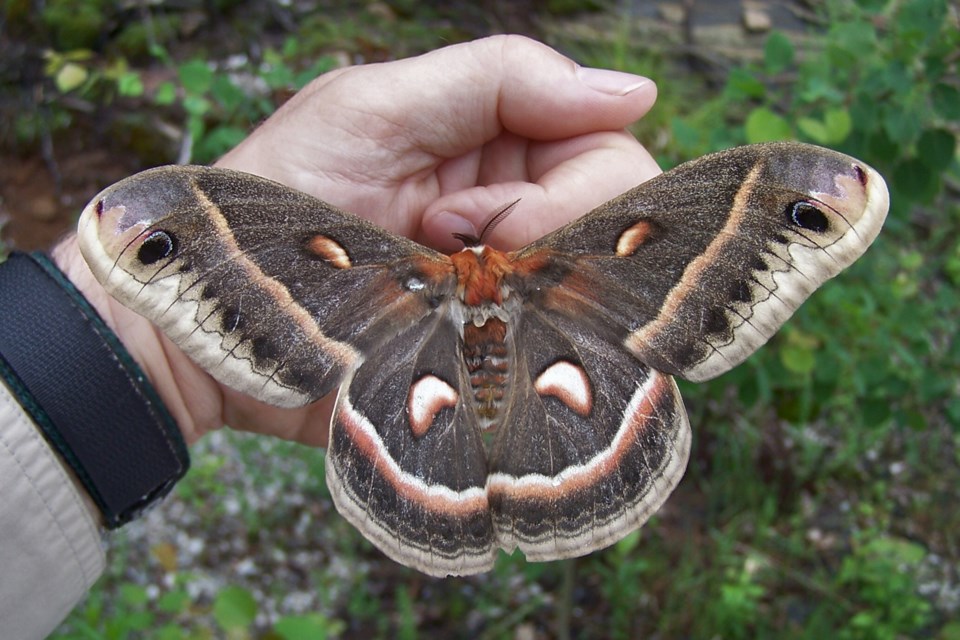They are big. They are bold. They are beautiful. They are elusive yet unmistakable when found. If you think I'm talking about Brad Pitt and Angelina Jolie you are so in the wrong column.
I am referring, of course, to the emergence of the giant silk moths … Luna, Cecropia and Polyphemous to be more precise. Although there are others in the family, these are the seemingly larger-than-life moths usually encountered. While there may be many, many, many other species of moths, if you are the kind of person who likes to see the biggest and the best… these silk moths are the jewels you've been looking for.
Early June is an incredible time of the year for Nature, with activities happening night and day, every day of the week. By day, wildflowers are erupting in to bloom, and young birds are popping out of eggs. By night, turtles are scurrying across roadways in search of gravel nesting areas, and moths are very focused as they fly about looking for Mr/Ms Right. Busy, busy, busy.
As with most life cycles, timing is everything. The hungry birdies hatch just as the insects emerge; the insects emerge just as the flowers and foliage are ready; the plants open their blooms when the required amount of heat units have occurred; heat units are compiled as each day gets warmer and warmer; the days get warmer as the planet spins closer to the sun; the sun… but perhaps I digress.
Silk moths. Once encountered, never forgotten. For people interested in Nature, these creatures are memorable, no matter how many times encountered. They’re just so darn big, you can't help but be fascinated by them.
They tend to be night flyers, and seem to like bright lights. Mercury vapour lights seem to suck them right out of the air, but the good ol' porch light with the energy-inefficient incandescent bulb will bring in a few as well. As sunlight sends them running (so to speak) you have to be an early riser to find the night moths still clinging to the porch wall.
Although both males and females are capable of flight, the males tend to be the stronger flyers. This is not a male macho thing, it's a nature-makes-sense thing. Eggs must be laid on a tree species that the emerging caterpillar is capable of eating. Last fall, when the caterpillars dropped down from the limbs of the trees they had been dining on, they wrapped themselves in a cocoon of fallen leaves. Now that they are emerging as adult moths, the weak-flying females just barely make it up to the overhead branches of the overhead tree.
However, if both males and females took this easy route, then brothers and sisters would be the only ones available to mate with on the same tree (ewww, that’s just wrong). So the stronger males fly far and free, while the females tend to stick close to the nurturing home tree. With some species of moths the females are actually flightless, thus the emerging girl moths have no choice but to climb the nearest tree.
But the males don't get away free and easy. While it's good that they fly away to meet new gals and spread the gene pool around, without a little coaxing they may forget just what it is they are supposed to be doing while gallivanting about the countryside. So the girls have a plan, a fairly good one as it turns out.
The female moths find a suitable branch to hang from, and when the sun goes down they begin sending out a message. It's not nearly as complicated as the text messaging on your handheld computer/phone/camera, but it works none-the-less.
The message to "come hither" is sent via pheromones, also know as perfume, or scent. Insidious stuff, this pheromone. Odour particles drift with the breeze and cover quite an area. Should an innocent and happy-go-lucky male moth fly into this particle stream, it's game over.
As the scent particles stick to his antennae, impulses are transmitted to his wing muscles. If the pheromone was picked up as coming from the left, his antenna relay a message to the left wings to cease flapping and his flight pattern is now switched to auto-pilot, as he can't break free of the stimulus. A nice gradual left wheel and the boy moth is about to fulfil his destiny. Target is sighted, locked on, meet the new wife.
The eggs are laid over the next few days. If the male escapes lady number one, he may find himself with lady number two the next night. But this wild and crazy lifestyle soon comes to an abrupt end, as death comes either from exhaustion (hey, they haven't eaten in two weeks… why, what were you thinking?) or being eaten by a bird trying to keep the home brood well fed.
Like the personalities sought by our press and paparazzi, giant silk moths are all the news for just a short time, then all but forgotten until the next time they seek a mate and do wild and crazy things. Life is nature, nature is life.
